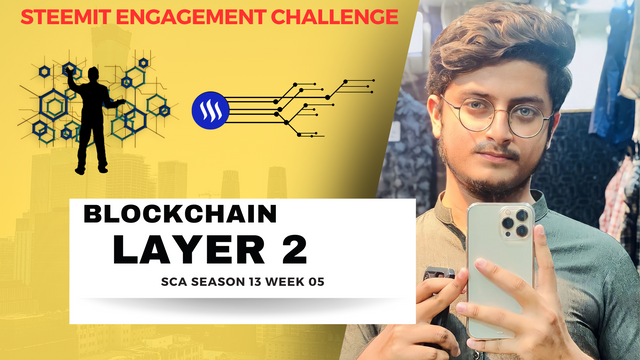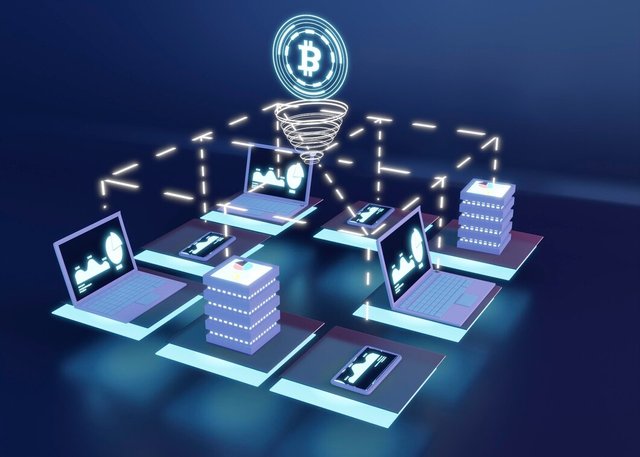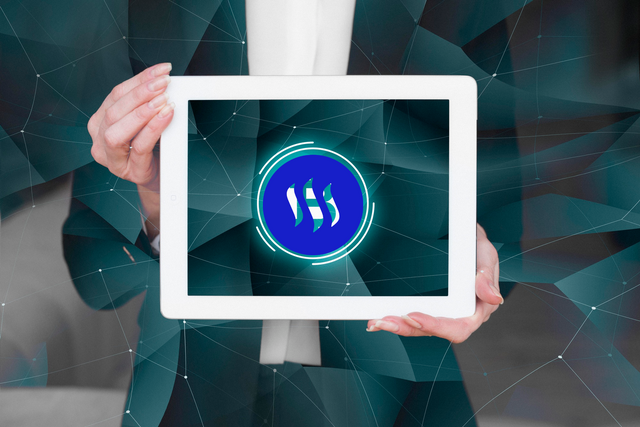Assalamualaikum everyone!
Welcome to the post. Hopefully, all of you will be doing well and enjoying the time with the grace and blessings of Almighty Allah. Today, I'm here to be a part of the week 5 contest in the beloved SteemitCryptoAcademy community. The topic of discussion for this week is very much informative, Layer 2 Blockchain. So, let's start the discussion without any wastage of time.

What is layer 2 in a blockchain and how does it differ from layer 1?
Before moving towards the Layer 2, let me explain the Layer 1. Layer 1 is the backbone of a blockchain network and is in charge of its essential functionality, such as security, consensus mechanisms, and data integrity. Decentralization and immutability are main focus in Layer 1 blockchains, although this generally comes at the expense of transaction processing and scalability.
Now, moving towards the Layer 2. Layer 2 actually refers to secondary protocols that are developed on top of an existing layer 1 blockchain. These solutions are implemented to overcome the scalability issues by enabling faster transaction processing and lower fees. They accomplish this by dumping a large percentage of the transaction workload from the main chain to the secondary layer.
Talking About the Main Differences...
The first and the most important differences between them is that the Layer 1 focuses more on security and decentralization, whereas Layer 2 prioritizes scalability and transaction efficiency. Another thing is that Layer 1 transactions take place on the main chain, whereas layer 2 transactions take place on a secondary chain or protocol.
Layer 1 processes transactions directly on the main chain, whereas Layer 2 processes transactions off-chain and occasionally fix them back into the main chain. Another difference is related to the transaction fees, because of the limited transaction capacity, layer 1 fees are normally higher, whereas layer 2 fees are frequently lower due to off-chain processing.

Moving Towards the Benefits of Layer 2 Solutions...
The most important advantage of Layer 2 solutions is the greater transaction handling capacity. TheLayer 2 solutions can process more transactions per second, allowing for faster processing. Lower transaction fees result from reduced load on the main chain is also another potential gain. Moreover, Layer 2 solutions solve scalability challenges, enabling blockchain to accommodate more applications and users.
Drawbacks of Layer 2 Solutions...
The most noticeable drawback of the Layer 2 is that additional security measures may be required to preserve overall security of the layer 2. Another thing is that, for widespread use, integration with existing infrastructure and developer assistance are required. Moreover, the each pf the layer 2 mechanism has its own set of trade-offs and limits.
Give real-world examples of Layer 2 solutions and explain how they work.
There are number of examples of the Layer 2 Solutions but the most popular are discussed below.
- Lightning Network for Bitcoin:
The Lightning Network is a Layer 2 solution for Bitcoin network that creates a network of off-chain payment channels that allow users to make multiple transactions without broadcasting them to the entire Bitcoin blockchain, significantly reducing transaction fees and improving transaction speed. The working of this Layer 2 Solution is discussed below. /
First of all, the users establish bilateral payment channels with one another, each channel containing a set amount of Bitcoin.
In the next step, payments made over the channel are handled off-chain, without being published to the main Bitcoin network.
In the end, the final balances are settled on the Bitcoin blockchain when the channel is terminated.
- Arbitrum for Ethereum:
Arbitrum is an Ethereum Layer 2 solution that achieves scalability using optimistic rollups. Optimistic rollups group transactions and process them off-chain, posting checkpoints to the Ethereum main chain on a regular basis. This method enables Arbitrum to process comparatively more transactions than Ethereum while maintaining the Ethereum blockchain's security as well. The working of Arbitrum is discussed below.
In the first step, the transactions are submitted to Arbitrum, which processes them off-chain.
Then, the off-chain transactions are monitored and validated by validators on the Arbitrum chain.
In the next phase, The state of the Arbitrum chain is summarized in periodic checkpoints and then posted to the Ethereum main chain.
- Optimism for Ethereum:
Optimism is another Layer 2 Ethereum solution that employs a similar optimistic rollup approach as Arbitrum. Optimism is designed to be compatible with Ethereum's existing ecosystem, making it simple for developers to launch and move their apps to the Optimism chain. It operates as follows:
First of allTransactions are sent to Optimism for off-chain processing.
The, the Optimism's fraud-proof technology detects and corrects fraudulent transactions., if present
In the third step, the periodic checkpoints are posted to the Ethereum main chain, ensuring the Optimism chain's integrity.
So, these are some of the popular Layer 2 solutions that has implemented in the most popular chains, Bitcoin and Ethereum. It is noticeable is that if there is any disruption occurs in the layer 2 transaction processing, the main chains are used to overcome the issues.
How does layer 2 help reduce transaction fees on a blockchain and facilitate interoperability between different blockchains??
As we have already discussed that the Layer 2 solutions are critical in overcoming two primary issues faced by the blockchain technology which are, transaction fees and interoperability between different blockchains. So, let's discuss these two points in more details.
- Reduction of the Transaction Fees:
Lower transaction costs are achieved by shifting a considerable portion of the transactions load from the primary blockchain to the secondary layer. This minimizes rush and load on the main chain, letting it to process transactions more efficiently and inexpensively.
For example, the Lightning Network for Bitcoin uses off-chain payment channels to combine many transactions and settle them on the main chain on a regular basis. This method drastically reduces the number of transactions broadcasted to the Bitcoin blockchain, hence lowering transaction costs.
Similarly, Layer 2 solutions for Ethereum, such as Arbitrum and Optimism, use optimistic rollups to process and combine transactions off-chain and publish checkpoints to the main chain. This decreases the frequency of costly on-chain transactions, resulting in cheaper costs and hence the gas fee is reduced considerably.
- Facilitating Interoperability:
Layer 2 solutions can also help with blockchain interoperability by providing bridges that allow for efficient communication and asset transfers across chains. These bridges use various ways to connect Layer 2 networks to their respective base chains, such as sidechains or multi-asset smart contracts.
Polygon, an Ethereum Layer 2 solution, has built bridges to many blockchains, including Bitcoin, Binance Smart Chain (BSC), and Polkadot. Users can utilize these bridges to transfer assets and data between various blockchains without the usage of intermediaries.
What is the underlying layer used by the Steem blockchain, and how does this layer facilitate transactions and interactions on the platform?
The Steem blockchain is actually developed on top of the Graphene framework, which acts as the blockchain's underlying infrastructure. Graphene is a high-performance blockchain platform that was created primarily to handle high-throughput applications such as Steem. It has various benefits that make it appropriate for Steem blockchain requirements:
The most important thing is the scalability concerns. The architecture of Graphene is designed to accommodate enormous transaction volumes without sacrificing speed or performance. To meet increasing transaction needs, it leverages techniques such as parallel processing and dynamic block size adjustment. So, this is helpful to improve the scalability of the network in overall.

We know that that Steem blockchain main layer is based on the Delegated Proof-of-Stake (DPoS)mechanism. It is Graphene's consensus mechanism, is more energy-efficient than classic consensus techniques such as Proof-of-Work (PoW). As a result, the network's environmental effect and operational expenses are reduced to a great extent.
Another important thing about the Graphene layer is that the modular architecture of graphene enables customization to specific blockchain applications. Steem has used this flexibility to develop features such as account freezing, resource management, and delegated curation, etc.
Moreover, the Graphene has been in development since 2015 and has demonstrated stability and reliability. Steem's reliability and capacity to handle massive user bases has benefited from this maturity as well. Graphene, in addition, serves as the foundation for Steem blockchain high-throughput capabilities, energy efficiency, adaptability, and overall stability. It provides a stable and scalable infrastructure for Steem's unique features and user base.
What would be the implications of integrating a layer 2 solution on the STEEM blockchain in terms of scalability, costs, and ease of use for users?
Integrating a Layer 2 solution onto the Steem blockchain could have a substantial impact on its scalability, transactions costs, and users ease to enjoy their time on the blockchain. There are some of the important points in this regard which are discussed below.
- Increased Scalability:
By transferring transaction processing from the main chain to a secondary layer, Layer 2 solutions solve the scalability restrictions of Layer 1 blockchains. This can dramatically increase the Steem blockchain's transaction processing power, allowing it to process a higher volume of transactions without sacrificing speed or overall performance.
- Transaction Fees are Reduced:
Lower transaction fees are frequently achieved by combining transactions and processing them off-chain. This remove a lot of rush and load of transactions from the main chain, resulting in cheaper transaction costs for Steem users.
- Improved User Experience:
Lower transaction fees and faster transaction processing can improve the overall user experience on the Steem blockchain dramatically. Users will be able to transact more efficiently and affordably, making the platform more appealing and accessible to a wide range of the users around the world.
- Adoption Incraeses:
Improved scalability, lower costs, and a better user experience may lead to greater Steem blockchain usage. More users will be encouraged to join the platform, which will broaden its reach and possible applications. So, it would be a great gain for the Steem blockchain in overall.
Conclusions
Layer 2 solutions are a possible option to overcome the blockchain technology's scalability and interoperability issues. Layer 2 solutions provide the way for a more efficient, integrated, and inclusive blockchain ecosystem by offloading transaction processing and facilitating cross-chain communication. Their integration with our beloved blockchain, Steem, has the potential to greatly improve transaction processing power, lower costs, and improve user experience, leading to increasing adoption and a broader range of applications as well.
I would like to invite my friends @drhira, @artist1111, @ngoenyi, and @f2i5 to be a part of this amazing contest.
 |  |  |  |
|---|

This is very nicely shared the difference between Layer 1 and Layer 2. After definitions. That was easy to understand over all. How does the layer 1 and 2 transactions takes place. In addition you shared advantages and disadvantages of layer 2 also. That is something new to read.
Graphene layer was a very new discovery to me. And I was amazed to see how it works. All actions on steemit are very nicely handled on the layer. Then specially the transaction process on steemit is way faster and at least free for users.
Some of new points I got to read, about adding new layer on steem Blockchain. Adoption Increase won the heart.
Assalam u alikum!
Downvoting a post can decrease pending rewards and make it less visible. Common reasons:
Submit
Wa alaikum salam. Jazakallah for such a nice review of my post brother
Downvoting a post can decrease pending rewards and make it less visible. Common reasons:
Submit
!upvote 40
🍀🎨Participate in the "Seven Network" Community🎨🍀
This post was manually selected to be voted on by "Seven Network Project". (Manual Curation of Steem Seven). Also your post was promoted on Twitter by the account josluds
Downvoting a post can decrease pending rewards and make it less visible. Common reasons:
Submit
the post has been upvoted successfully! Remaining bandwidth: 160%
Downvoting a post can decrease pending rewards and make it less visible. Common reasons:
Submit
Your post has been rewarded by the Seven Team.
Support partner witnesses
We are the hope!
Downvoting a post can decrease pending rewards and make it less visible. Common reasons:
Submit
X Share Link:
https://twitter.com/mrsheraz7588/status/1725464525577568567?t=S2lLcZb9DyNp0UJ9xM0E_w&s=19
Downvoting a post can decrease pending rewards and make it less visible. Common reasons:
Submit
Indeed we learn everyday and your post is one of the post i just learned something new to me which is "Graphene".
You have explained all the given questions perfectly well sir. Good luck to you.
Downvoting a post can decrease pending rewards and make it less visible. Common reasons:
Submit
Thanks for the comment dear
Downvoting a post can decrease pending rewards and make it less visible. Common reasons:
Submit
Upvoted. Thank You for sending some of your rewards to @null. It will make Steem stronger.
Downvoting a post can decrease pending rewards and make it less visible. Common reasons:
Submit
Como bien lo escribes la Capa 1 como cadena principal gobierna lo esencial, la seguridad, los mecanismos de consenso y la protección de los dato. La Capa 2 trabaja para la Capa 1 en un plano paralelo o secundario en la cual procesa más rápido, eficientemente y menos costoso, las transacciones y la escalabilidad. De esto se trata el tema del papel que juega la Capa 2 para contribuir y mejorar el rendimiento de la blockchain principal.
Gracias por tan buen contenido del cual he aprendido un mucho. ¡Un fuerte abrazo!
Downvoting a post can decrease pending rewards and make it less visible. Common reasons:
Submit
Thanks for your precious comment. Greetings 🤗
Downvoting a post can decrease pending rewards and make it less visible. Common reasons:
Submit
It is very obvious that Layer 2 is a must for the general adoption of Blockchain as a payment system. You have shown and explained very well what Layer 2 is, that even an ordinary person can easily understand it.
Thank you so much for such insightful writeup.
Downvoting a post can decrease pending rewards and make it less visible. Common reasons:
Submit
Thanks a lot for your precious words, means a lot.
Downvoting a post can decrease pending rewards and make it less visible. Common reasons:
Submit
Peace be upon you ! your comprehensive explanation of Layer 1 and Layer 2 in blockchain is incredibly insightful. Layer 1s focus on security and decentralization while Layer 2 prioritizes scalability is well-articulated. The real-world examples like Lightning Network and Arbitrum make complex concepts easily understandable. your breakdown of how Layer 2 reduces transaction fees through off-chain processing and enhances interoperability is commendable. Additionally your exploration of Steem's underlying layer Graphene sheds light on its scalability & energy efficiency. Integrating Layer 2 solutions on Steem could indeed elevate scalability reduce costs and enhance user experience. Best wishes for success
Downvoting a post can decrease pending rewards and make it less visible. Common reasons:
Submit
Your post has been successfully curated by @𝐢𝐫𝐚𝐰𝐚𝐧𝐝𝐞𝐝𝐲 at 35%.
Thanks for setting your post to 25% for @null.
We invite you to continue publishing quality content. In this way you could have the option of being selected in the weekly Top of our curation team.
Downvoting a post can decrease pending rewards and make it less visible. Common reasons:
Submit
Thanks a lot @irawandedy brother
Downvoting a post can decrease pending rewards and make it less visible. Common reasons:
Submit
Greetings Dr shb ,
Thank you for sharing comprehensive insights into Layer 2 solutions. Your breakdown clarifies thire role, benefits, and implications on scalability, costs, and user experience, outlining their potential in blockchain advancement.
Downvoting a post can decrease pending rewards and make it less visible. Common reasons:
Submit
Thank you khan sab.
Downvoting a post can decrease pending rewards and make it less visible. Common reasons:
Submit